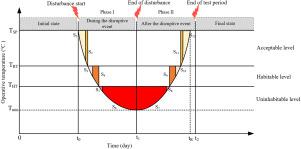Building and Environment ( IF 7.1 ) Pub Date : 2021-06-02 , DOI: 10.1016/j.buildenv.2021.108022 Shabnam Homaei , Mohamed Hamdy

|
The resilient building design has become necessary within the increasing frequency and intensity of extreme disruptive events associated with climate change. Since thermal comfort is one of the main requirements of occupants, evaluating building resilience from a thermal perspective during and after disruptive events is necessary. Most of the existing thermal resilience metrics focus on thermal performance only during disruptive events. Building designers are still seeking metrics that can capture thermal resilience in both phases (i.e. during and after the disruptive events). This paper introduces a novel benchmarking framework and a multi-phase metric for thermal resilience quantification. The metric evaluates thermal resilience concerning building characteristics (i.e. building envelope and systems) and occupancy. It penalises for thermal performance deviations from the targets based on the phase, the hazard level , and the exposure time of the event. The introduced methodology is validated by quantifying the thermal resilient performance of six building designs against a four-day power failure as a disruptive event. The six designs represent minimum and passive building requirements with and without batteries or photovoltaics as resilience enhancement strategies. For the considered case study, upgrading the building from the minimum to the passive design has a huge impact (71%) on resilience improvement against power failure in winter. The application of the battery and PVs can improve the thermal resilience of the two designs in the range of 19%–27% and 44%–60%, respectively. Findings can provide a useful reference for building designers to benchmark the building’s thermal resilience and constitute resilience enhancement measures.
中文翻译:

热弹性建筑:如何量化?一种新颖的基准测试框架和标签度量
在与气候变化相关的极端破坏性事件的频率和强度不断增加的情况下,弹性建筑设计变得必要。由于热舒适性是居住者的主要要求之一,因此有必要在破坏性事件期间和之后从热学角度评估建筑弹性。大多数现有的热弹性指标仅关注破坏性事件期间的热性能。建筑设计师仍在寻找能够在两个阶段(即在破坏性事件期间和之后)捕捉热弹性的指标。本文介绍了一种新颖的基准测试框架和用于热弹性量化的多阶段指标。该指标评估与建筑特征(即建筑围护结构和系统)和入住率相关的热弹性。它根据阶段、危险级别和事件的暴露时间对偏离目标的热性能进行处罚。引入的方法通过量化六种建筑设计的热弹性性能来验证,以应对为期四天的电力故障作为破坏性事件。这六种设计代表了使用和不使用电池或光伏作为弹性增强策略的最低和被动式建筑要求。对于所考虑的案例研究,将建筑物从最小设计升级为被动设计对提高冬季停电恢复能力具有巨大影响 (71%)。电池和光伏的应用可以将两种设计的热回弹性分别提高19%~27%和44%~60%。











































 京公网安备 11010802027423号
京公网安备 11010802027423号